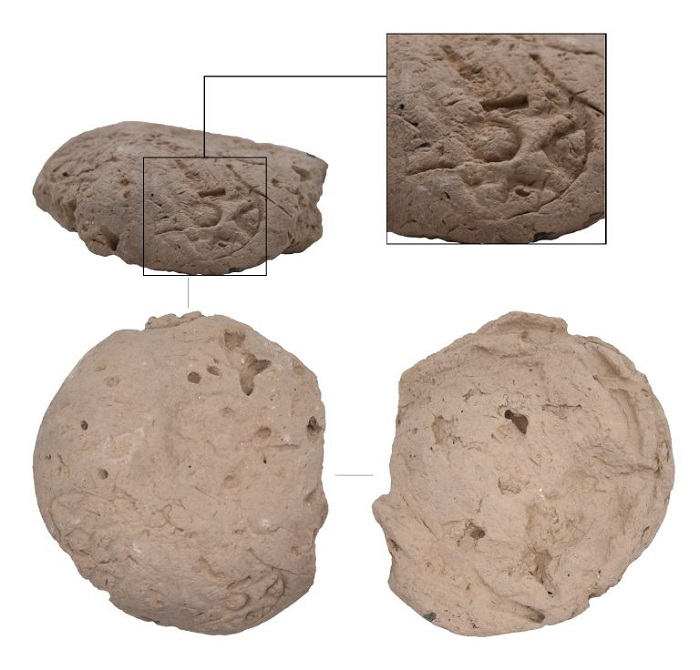 Russian and Turkmen archaeologists conducting excavations at the Gonur-Depe settlement in the Karakum Desert have unearthed a seal featuring a celestial body and a distinctive arrangement of three stars. This is believed to be the oldest known depiction of an astronomical object found in Turkmenistan.
Russian and Turkmen archaeologists conducting excavations at the Gonur-Depe settlement in the Karakum Desert have unearthed a seal featuring a celestial body and a distinctive arrangement of three stars. This is believed to be the oldest known depiction of an astronomical object found in Turkmenistan.
Nadezhda Dubova, a leading researcher at the Institute of Ethnology and Anthropology of the Russian Academy of Sciences and head of the Russian-Turkmen Margian archaeological expedition operating in southeastern Turkmenistan, told about this discovery in interview with TASS.
The Gonur-Depe settlement has been the focus of archaeological research for over five decades. Located in the ancient delta of the Murghab River, it thrived as an extensive oasis during the Bronze Age, around the 3rd and 2nd millennia BC. This was the land of Margush, or Margiana, mentioned in ancient texts.
 “During this year’s excavations, we have expanded our extensive collection of Gonur seals, which now numbers several hundred, with 11 additional seals. One of these is particularly intriguing. While we have previously discovered seals depicting individual stars, crescents, and other astronomical objects, this seal is unique due to its specific arrangement of three stars. Interestingly, the Turkmens have a constellation called ‘Uch yildiz’ (‘Three Stars’). We initially hypothesized that this seal represented an astronomical object, and it now appears to be the oldest such seal found in Turkmenistan. However, to confirm this with absolute certainty, astronomers will need to analyze the find,” Dubova explained.
“During this year’s excavations, we have expanded our extensive collection of Gonur seals, which now numbers several hundred, with 11 additional seals. One of these is particularly intriguing. While we have previously discovered seals depicting individual stars, crescents, and other astronomical objects, this seal is unique due to its specific arrangement of three stars. Interestingly, the Turkmens have a constellation called ‘Uch yildiz’ (‘Three Stars’). We initially hypothesized that this seal represented an astronomical object, and it now appears to be the oldest such seal found in Turkmenistan. However, to confirm this with absolute certainty, astronomers will need to analyze the find,” Dubova explained.
Among the notable discoveries made in 2024 at Gonur Depe are evidence of established gypsum production and the skull of an animal resembling a horse.
Previously, eight horse remains had been unearthed at the site, but only one horse skull. The archaeologist also mentioned that researchers have been working for several years to compile a comprehensive catalog of all the finds from the Margian expedition, spanning a period of 50 years.
“This catalog encompasses tens of thousands of discoveries,” the archaeologist explained.
About the expedition
The history of the Russian-Turkmen Margian expedition is associated with the name of the outstanding Russian archaeologist Viktor Sarianidi, who owns two of the largest archaeological discoveries of the 20th century. In 1978-1979, near the city of Shibargan in Afghanistan, he found seven royal tombs of the first century BC, which contained more than 20 thousand gold objects – one of the largest treasures ever found by archaeologists.
By the end of the 1980s, he had opened more than 200 settlements in the Merv oasis in southeastern Turkmenistan, the center of which was Gonur-Depe. These excavations testified to the existence of a previously unknown center of civilization of the Ancient East – the Bactrian-Margian archaeological culture dating back to the Bronze Age in Central Asia.
According to Dubova, at the moment there is a consensus among scientists that this culture can be called a civilization. At the same time, she notes that artifacts similar to the finds in Gonur Depe are found in territories from the Gulf of Oman and western Türkiye to India, the Pamirs and the southern regions of Turkmenistan, Uzbekistan. ///nCa, 22 October 2024